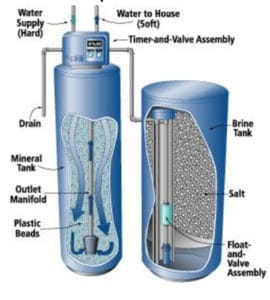Q: I installed a whole-house water softener for our well water but the water still tastes bad? Is this due to my water softener or is there any other issue? Thanks – Kathy
A: In most cases, water softeners have little effect on the taste of drinking water. They might make it a little better or a little worse, or have no effect at all. This is a side effect of the softening process that depends on the makeup of the incoming water and, to some extent, on the type of water softener used.
Purpose of Water Softeners
Most people install water softeners to make it easier to make soap suds and to rinse them off when bathing and cleaning. Hard water makes detergents less effective at removing dirt and grease. Another benefit of water softeners is that they prevent the buildup of mineral scale on water heaters, dishwashers, and other appliances that reduces their efficiency and can shorten their life.
How Water Softeners Work

Water softeners accomplish their task by removing dissolved minerals from the household water – mainly magnesium and calcium – and replacing them with sodium ions. The sodium comes from salt (sodium-chloride) that the homeowner adds periodically in either pellet or crystal form.
`
The main water softener tank contains plastic beads (resin) covered with sodium ions. As household water flows through the resin, the positively charged calcium and magnesium ions stick to the negatively charged resin, replacing the sodium which is released into the household water.
Over time, the resin becomes saturated with calcium and magnesium ions and must be recharged by flushing with a saltwater solution from the unit’s brine tank. This usually occurs every few days late at night. During this process, the concentrated sodium ions displace the calcium and magnesium ions which get flushed down the drain in the salty water. And the cycle begins over again.
Periodically, the homeowner needs to add a bag of salt to the brine tank to keep the
process going. How often depends on the size of the tank and hardness of the water. It is important to set the system to the hardness of the incoming water or you may be wasting salt and adding extra sodium to your drinking water.
Taste the Water
As mentioned above, water softeners are not intended to improve the taste of water, but removing the magnesium and/or calcium may change it a little. Some people prefer the water with more mineral content, especially the calcium. Others prefer softened water especially in tea or coffee. It’s pretty subjective. Where the original water flavor is preferred, it’s easy to bypass the water softener and direct unfiltered water to the tap or dispenser used for drinking water.
You can also run this line through a separate filter, such as activated charcoal, to remove most unpleasant tastes. Alternately, you can use a countertop device such as a Brita, to filter this water that bypassed the water softener..
Water softeners can remove a small amount of iron, which could improve the taste of the water. For larger amounts of iron, you will need to add a special filter to the water softening unit. Insoluble “red-water” iron and soluble invisible iron need different types of filters.
For example, removing iron can remove an unpleasant metallic taste. Removing magnesium and calcium can make subtle changes, which may homeowners may find good or bad. The small amount of sodium add to the soft water is tasteless if the system is functioning properly.
Other taste problems may be caused by sulfur (think rotten eggs) organic materials, which can usually be solved with an activated charcoal filter. Highly acidic water can also cause problems in combination with copper plumbing. The acidic water leaches copper from water pipes giving the water a metallic taste and leaving bright blue stains on sinks and tubs. The solution is an acid-neutralizing filter.
Salt Intake & Health
The small amount of sodium added to the water is low and generally not tasted. If it were a commercial beverage, the FDA would consider it “low-sodium.” The amount of sodium varies with the hardness of the water.
For a hardness level of 7 to 10 grains per gallon (GPG), the softened water will contain about 18 mg of added salt per 8 oz. glass of water. Water from 3 to 6 GPG is considered moderately hard and over 10 very hard. Softened water with an initial hardness of 5 will have half the sodium of water with an initial hardness of 10.
For a rough estimate, you can use this rule of thumb:
Grains Per Gallon x 8 = mg salt/liter water
So, for example, water with a hardness rating of 10 grains per gallon would contain this much salt:
10 x 8 = 80 mg salt per liter of water
For comparison, a tablespoon of ketchup contains about 160 mg. of salt and the average American consumes 3,400 mg of salt a day, about 1,00 more than recommended by the American Heart Association.
For people on a low salt diet, the extra salt might be a concern. One option is to use the more expensive potassium chloride to recharge the brine tank. Another approach is to have the plumber bypass the water softener for the faucet you use for drinking water. This can also address taste issues if you prefer the taste of the hard water, as some do.
The only way to remove the salt altogether is to use a reverse-osmosis system downstream from the water softener. These are expensive to install and operate, so they are only worth considering if you have badly polluted water that is difficult to clean any other way. The resulting water is similar to distilled water, with very little mineral content – not a water taste everyone likes. That’s why so many people buy “spring water” rather than distilled water for drinking. – Steve Bliss, BuildingAdvisor.com
Read More on Water Softeners Hard Water Water Quality
Leave a Reply